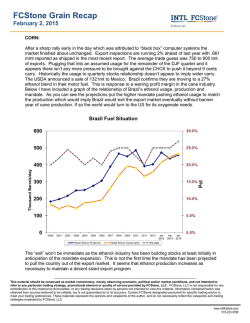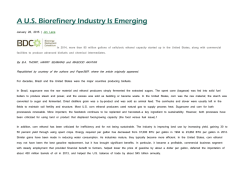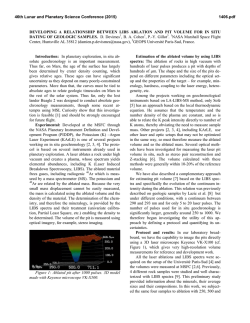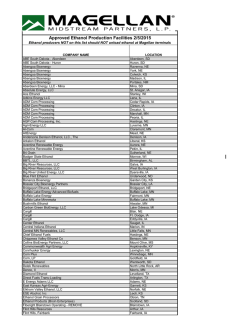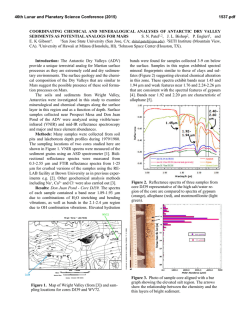
Supporting Information Purified dispersions of graphene in a
Electronic Supplementary Material (ESI) for ChemComm. This journal is © The Royal Society of Chemistry 2015 Supporting Information Purified dispersions of graphene in a nonpolar solvent via solvothermal reduction of graphene oxide Fei Zhenga, Wei-Long Xua, Han-Dong Jina, Meng-Qi Zhua, Wei-Hao Yuana, Xiao-Tao Hao,*a Kenneth. P. Ghigginob a School of Physics and State Key Laboratory of Crystal Materials, Shandong University, Jinan 250100, China b School of Chemistry, The University of Melbourne, Parkville, Victoria 3010, Australia Corresponding author: [email protected] Experimental Section DDAB assisted phase transfer of GO and separation of OD from GO Graphite oxide powder, purchased from XFNANO Materials Tech Co., Ltd. (Nanjing, China), was synthesized by Hummer’s method as declared by the manufacturer. 200 mg graphite oxide powder was added to 200 ml deionized (DI) water followed by one week magnetic bar stirring. Then this suspension was subjected to water-bath ultrasound sonication (200 W) for 30 min at room temperature to obtain 1 mg/ml aqueous dispersion of GO as stock. Didodecyl dimethyl ammonium bromide (DDAB) was purchased from Aladdin (Shanghai, China) and used without further purification. 200 mg DDAB (solid) was added to 100 ml DI water and stirred until the solid disappeared. Then 100 ml ethanol was added followed by a few minutes’ stirring to obtain 1mg/ml DDAB solution dissolved in water/ethanol (1:1) as stock. 4 ml DDAB solution was added to 4 ml GO aqueous dispersion with shaking to accomplish the ionic functionalization process of GO by DDAB, leading to the coagulation of DDAB-GO. 4 ml ortho-dichlorobenzene (DCB) was added to the resulting suspension followed by simple shaking and allowed to stand for a few minutes. After the removal of supernate containing water/ethanol, with DDAB and DDAB-OD dissolved in it, DDAB functionalized dpGO (DDAB-dpGO) dispersion in DCB was obtained. For purification, 4 ml ethanol was added to the obtained DCB dispersion and the dispersion mixture was subjected to ultra-sound sonication for 5 minutes. To extract the ethanol, 4 ml DI water was added to this mixture immediately followed by stirring for 6 hours. After standing for 1 hour, the supernate was then removed leaving a homogeneous dispersion of DDAB-dpGO in DCB with a concentration of ~1 mg/ml. This purification process may be repeated several times to further improve the purity of DDAB-dpGO. (Figure S5, upper panel) The weight ratio of the attached DDAB to dpGO in the final obtained DDABdpGO is difficult to determine but is obviously much less than 1:1. Only the weight of dpGO is taken into account although DDAB cations are attached and the approximation that dpGO is the majority of GO in mass is made when referring to the concentration of DDAB-dpGO dispersions in DCB. Only then can the concentration of DDAB-dpGO be estimated and easily controlled by adjusting the volume ratio of DCB to water during the extraction procedure as the concentration of the GO aqueous dispersion can be accurately controlled. The concentration of DDAB-dpGO DCB dispersions can also be to a high value (up to 5 mg/ml) either by improving the concentration of the original GO aqueous dispersion or by iterative phase transfer as schematically shown in Figure S6. Solvothermal reduction of DDAB functionalized dpGO 4ml N,N-dimethylformamide (DMF) was added to the as prepared DCB dispersion of DDAB-dpGO (1 mg/ml). Then this mixture was fed into a 15 ml glass tube and placed into an oil bath at 130 ℃ and stirred for 12 h. The resulting black dispersion was cooled to room temperature, then 4 ml ethanol was added to it immediately followed by stirring for 6 h. After standing, a distinct phase separation then took place with black DCB dispersion of DDAB-rGO (4 ml) at the bottom of vessel and colorless supernate (8 ml) composed of ethanol/DMF mixture at the top. (Figure S5, bottom panel) Polymer-graphene hybrid solution Regioregular poly(3-hexylthiophene) (P3HT) was purchased from Sigma-Aldrich Co. and dissolved in DCB to a concentration of 5 mg/ml to provide a stock solution. Amounts of this stock solution were then mixed with 1 mg/ml DDAB-rGO dispersions in the weight ratio of 1:0.1, 1:0.2 (P3HT: graphene) and diluted to 1 mg/ml (only referring to P3HT) by adding excess DCB. The mixed solutions were stirred for 12 h using a magnetic bar. 1 mg/ml pure P3HT solution was also prepared by diluting the 5 mg/ml stock solution and stirred for 12 h. Fourier transform infrared spectroscopy (FTIR) measurement FTIR spectra of DDAB, supernate-1, supernate-2, GO, DDAB-dpGO, DDAB- rGO film samples deposited from the corresponding solution onto SiO2 (100 nm)-Si wafer substrates were obtained using a Fourier transform infrared spectrometer (Vertex-70, Bruker, Co.) in the single channel mode. Raman measurement 1 mg/ml GO aqueous dispersion and DDAB-GO dispersions in DCB after phase transfer (DDAB-GO-1) and undergoing purification process (DDB-GO-2) were drop casted onto 2 cm*2 cm quartz substrates and dried for the Raman measurement. Raman spectra of three samples were obtained by a confocal Raman microscope (LabRam HR800) with a laser excitation of 633 nm. Photoluminescence (PL) measurement Photoluminescence properties of Supernate-1, supernate-2, 1 mg/ml GO aqueous dispersion and DDAB-GO DCB dispersion in quartz cells of 10 mm optical path length were investigated by 380 nm laser excitation. P3HT, P3HT: DDAB-rGO (1: 0.1), P3HT: DDAB-rGO (1: 0.2) dissolved in DCB at 1 mg/ml placed in quartz cells with 1 mm optical path length were excited by 400 nm laser. All the steady state PL spectra were obtained by a fiber optic spectrometer (PG2000-Prn, Morpho Inc.). Optical absorbance measurement The UV-vis absorbance spectrum of GO aqueous dispersions (diluted from 1 mg/ml stock dispersion), DDAB-dpGO, DDAB-rGO DCB dispersions (diluted from 1 mg/ml stock dispersion) were measured by a UV-vis-near infrared spectrophotometer (U-4100, Hitachi) in quartz cells of 10 mm optical path length. Solid samples of GO, DDAB-dpGO, DDAB-rGO were made by depositing the corresponding dispersions onto quartz slides and their UV-vis absorption spectra were measured by a UV-visible dual-beam spectrophotometer (TU-1900, PG Instruments Co., Ltd.). Atomic Force Microscopy (AFM) measurement AFM images of GO, DDAB-dpGO, DDAB-rGO were obtain using a Multimode Scanning Probe Microscope (NanoScope-ⅢA, Veeco Metrology Group) in the tapping mode. Samples were prepared by spin-casting corresponding dispersions (diluted to 0.05 mg/ml) onto SiO2 (300 nm) /Si substrates and vacuum dried. X-ray photoelectron spectroscopy (XPS) measurement Film samples for XPS measurement were prepared by drop-casting GO aqueous dispersion (1 mg/ml), DDAB-dpGO DCB dispersion (1 mg/ml), DDAB-rGO DCB dispersion (1 mg/ml) onto silicon wafers followed by vacuum drying overnight. Measurements were made using a X-ray Photoelectron Spectrometer (Escalab-250, Thermo Electron Co.). The C 1s spectra of the three samples were analyzed using a Shirley-kind background and fitted with Lorentzian-Gaussian peak profiles. Film conductivity measurement 1 mg/ml GO aqueous dispersion and DDAB-dpGO, DDAB-rGO dispersions in DCB were drop casted on quartz substrates and dried. A set of electrodes separated by 20, 15, 10, 8 μm contacting the deposited films were fabricated by photolithography and depositing 5 nm Ti layer followed by 50 nm Au.1 Current-voltage (I-V) curves for reflecting the films conductivity were performed by 2-probe technique using the Semiconductor Parameter Analyzer (Agilent B1500A). Up conversion measurement A femtosecond pulse laser (Mai Tai-HP, Spectra-Physics Company) combined with a frequency doubler (Inspire Blue) was used to provide 800 nm laser pulses and 400 nm laser pulses (80 MHz) for the fluorescence up-conversion measurements of P3HT, P3HT: DDAB-rGO (1:0.1), P3HT: DDAB-rGO (1:0.2) solution samples in quartz cells of 1 mm optical path length. Fluorescence decay curves were obtained by a time-resolved fluorescence measurement system (Halcyone, Ultrafast Systems Inc.) in the up-conversion mode. Supplemental figures Figure S1. Digital photographs of DDAB functionalization of GO and phase transfer of DDAB-GO from water/ethanol to DCB with different DDAB dissolution forms: (a) 1 mg/ml DDAB solution in water (0% ethanol); (b) 1 mg/ml DDAB solution in water/ethanol (1:1) (50% ethanol); (c) 1 mg/ml DDAB solution in ethanol absolute (100% ethanol). The volumes of original GO aqueous dispersions (1 mg/ml), DDAB solutions and DCB added are all 3 ml. The phase separation results for the solvents and DDAB-GO transfer efficiency from water to DCB under 3 conditions imply DDAB dissolved in 50% ethanol (ethanol: water=1:1) is optimal. Figure S2. Digital photographs of DDAB functionalization of GO and phase transfer of DDAB-GO from water to DCB with different ratio of DDAB to GO: (a) 1:3, the concentration of DDAB in 50% ethanol added was set to be 1/3 mg/ml; (b) 1:2, DDAB in 50% ethanol (0.5 mg/ml); (c) 1:1, DDAB in 50% ethanol (1 mg/ml). The volumes of original GO aqueous dispersions (1 mg/ml), DDAB solutions and DCB added are all 3 ml. The results indicate that the more DDAB added, the higher the DDAB-GO transfer efficiency is. However excess DDAB may have negative influence on the performance of transferred GO, thus the relative amount of DDAB should be minimized. The weight ratio of added DDAB to GO of 1:1 is considered to be optimum. Figure S3. The as transferred DDAB-GO dispersion in DCB without purification process coagulated again after 1 hour standing. The extreme uniformity of DDAB-GO DCB dispersion and the clear interface between DCB and the water/ethanol mixture appear after the purification process. Figure S4. (a) The PL spectra of supernate-1, supernate-2, 1 mg/ml GO aqueous dispersion and DDAB-GO DCB dispersion under 380 nm laser excitation. (b)The PL spectra of supernate-1 under 380, 400, 420 nm laser excitation. The PL spectra of both supernates are distinct from that of GO sheets dispersed in water as well as transferred to DCB (DDAB-GO), thus excluding the presence of GO sheets in the supernates. The PL peaks of supernates around 500 nm are almost independent of excitation wavelength, implying this emission peak might be derived from the quasi-molecular structures2 rather than the solvent induced Raman scatter3 (the sharp double peaks existed). Figure S5. Flow chart composed of digital photographs of dispersions illustrating the phase transfer of DDAB-GO and purification of DDAB-GO in DCB (upper panel), and the reduction procedure from DDAB-dpGO to DDAB-rGO (bottom panel). Figure S6. Schematic of iterative phase transfer of DDAB-dpGO: After the first round phase transfer, the obtained DDAB-dpGO DCB dispersion was repeatedly added to DDAB-GO suspension in water/ethanol mixture to extract DDAB-dpGO, thus gradually improving its concentration. Figure S7. The current-voltage (I-V) curves of GO and DDAB-rGO deposited films. These data demonstrate a huge enhancement of electrical conductivity from GO to DDAB-rGO after phase transfer and solvothermal reduction, implying the recovering of sp2 conjugating in GO sheets. Unfortunately, due to the considerable existence of DDAB molecules in DDAB-dpGO deposited film, it was found to be insulating during the film conductivity measurement. References. 1. I. Jung, D. A. Dikin, R. D. Piner and R. S. Ruoff, Nano Lett., 2008, 8, 4283. 2. D. Kozawa, Y. Miyauchi, S. Mouri and K. Matsuda, J. Phys. Chem. Lett., 2013, 4, 2035. 3. Z. Guo, S. Wang, G. Wang, Z. Niu, J. Yang and W. Wu, Carbon, 2014, 76, 203.
© Copyright 2025
